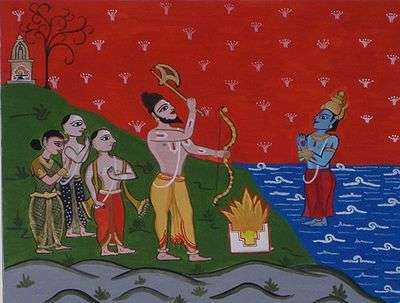Saraswat Brahmin
The Saraswats are a sub-group of Hindu Brahmins of India who trace their ancestry to the banks of the Rigvedic Sarasvati River. The Saraswat Brahmins are mentioned as one of the five Pancha Gauda Brahmin communities.[1][2][3]

History
In Kalhana's Rajatarangini (12th century CE), the Saraswats are mentioned as one of the five Pancha Gauda Brahmin communities residing to the north of the Vindhyas.[2] They were spread over a wide area in northern part of the Indian subcontinent. One group lived in coastal Sindh and Gujarat, this group migrated to Bombay State after the partition of India in 1947. One group was found in pre-partition Punjab and Kashmir most of these migrated away from Pakistan after 1947. Another branch known as Dakshinatraya Saraswat Brahmin are now found along the western coast of India.[3][4]
Culture
Social status
Kashmir
According to M. K. Kaw (2001), Kashmiri Pandits, a part of the larger Saraswat Brahmin community hold the highest social status in Kashmir.[5]
Maharashtra
Historically, in Maharashtra, Saraswats had served as low and medium level administrators under the Deccan Sultanates for generations. In 18th century, the quasi-independent Shinde and the Holkar rulers of Malwa recruited Saraswats to fill their respective administrative positions.This made them wealthy holder of rights both in Maharashtra and Malwa during the eighteenth century. During the same period in Peshwa ruled areas, there was a continuation of filling of small number of administration post by the Saraswats.[6] In Maharashtra, till the rise of Peshwas, the Chitpavans held low social status and other Brahmins refused to dine with them[7] however during the rule of the Chitpavan Brahmin Peshwas in the 18th century, Saraswat Brahmins was one of the communities against whom the Chitpavans conducted a social war which led to Gramanya (inter-caste dispute).[8][9]
After the liberation of Goa from the Portuguese colonial rule in 1961, many Goan Saraswats opposed merger of Goa into Maharashtra.[10]
Diet
Konkan and Goa
In Goa, the Saraswat Brahmins have fish as a part of their diet.[11] The Saraswat Brahmins of the Konkan region also eat fish.[12]
Karnataka
In coastal districts of Karnataka, Gaud Saraswats are the Madhva Vaishnavite Saraswat Brahmins, followers of Madhvacharya, while the Saraswats are Smarthas, followers of Shankaracharya.[13] They are largely vegetarians.[14]
Others
Saraswat Brahmins from northern and eastern India also include fish in their diet.[15][16][17]
Marriages
The Saraswat Brahmins are divided into various territorial endogamous groups, who at one time did not intermarry.[18] According to the sociologist, Gopa Sabharwal (2006),[19] marriages between Saraswat and non-Saraswat Brahmins are on the increase though they were unheard of before, mainly because the Saraswats eat fish and occasionally meat, while all other Brahmins in that region are vegetarians.[20][21]
See also
- Canara Konkani
- Gaud Saraswat Brahmin
- Rajapur Saraswat Brahmin
- Gauda Brahmins
References
- Shree Scanda Puran (Sayadri Khandha) -Ed. Dr. Jarson D. Kunha, Marathi version Ed. By Gajanan shastri Gaytonde, published by Shree Katyani Publication, Mumbai
- D. Shyam Babu and Ravindra S. Khare, ed. (2011). Caste in Life: Experiencing Inequalities. Pearson Education India. p. 168. ISBN 9788131754399.
- James G. Lochtefeld (2002). The Illustrated Encyclopedia of Hinduism: N-Z. Rosen. pp. 490–491. ISBN 9780823931804.
- Dakshinatya Sarasvats: Tale of an Enterprising Community,page 6
- M K, KAW (2017). Kashmiri Pandits: Looking to the Future. APH Publications. pp. 32–33. ISBN 9788176482363.
- Gordon, Stewart (2017). The Marathas 1600-1818, Volume 2. Cambridge university press. pp. 130–145. ISBN 9780521033169.
- Gordon, Stewart (2017). The Marathas 1600-1818, Volume 2. Cambridge university press. pp. 130–145. ISBN 9780521033169.
- Gokhale, Sandhya (2008). The Chitpwans. Shubhi Publications. p. 204.
The jati disputes were not a rare occurrence in Maharashtra. There are recorded instances of disputes between jatis such as Chandraseniya Kayastha Prabhus and the Chitpawans, Pathare Prabhus and the Chitpawans, Saraswats and the Chitpawans and Shukla Yajurvedi and the Chitpawans. These intra-caste dispute involving the supposed violation of the Brahmanical ritual code of behavior was called Gramanya in marathi.
- Gazette of Bombay presidency. 1885. pp. 100–101. Retrieved 1 May 2019.
- Arun Sinha (2002). Goa Indica: A Critical Portrait of Postcolonial Goa. Bibliophile South Asia. p. 50. ISBN 8185002312. Retrieved 6 July 2019.
- Maria Couto (2005). Goa: A Daughter's Story. Penguin Books India. p. 4. ISBN 978-0-14-303343-1.
- Understanding Society: Readings in the Social Sciences. Macmillan International Higher Education. October 1970. p. 273. ISBN 9781349153923. Retrieved 4 March 2019.
- S. Anees Siraj (2012). Karnataka State: Udupi District. Government of Karnataka, Karnataka Gazetteer Department. p. 189.
- The Illustrated Weekly of India, Volume 91, Part 2. Published for the proprietors, Bennett, Coleman & Company, Limited, at the Times of India Press. 1970. p. 63.
The Saraswats are largely a vegetarian community, whose coconut- based cuisine is famed for its variety.
- Frederick J. Simoons (1994). Eat Not this Flesh: Food Avoidances from Prehistory to the Present. University of Wisconsin Press. p. 284. ISBN 9780299142506.
- Kaw, M. K. (2001). Kashmiri Pandits: Looking to the Future. APH Publishing. ISBN 9788176482363. Retrieved 7 April 2019.
- "Forward castes must think forward as well". Hindustan Times. 23 November 2014. Retrieved 18 March 2019.
- Kumar Suresh Singh (1998). India's Communities, Volume 6. Oxford University Press. p. 3175.
The Saraswat Brahman are an ancient and a dynamic community of India, spread from Jammu and Kashmir to Konkan. They are divided into various territorial endogamous groups, who at one time did not intermarry.
- "Department Of Sociology:Dr. Gopa Sabharwal". Retrieved 28 December 2019.
- Gopa Sabharwal (2006). Ethnicity and Class: Social Divisions in an Indian City. Oxford University Press. p. 131. ISBN 9780195678307.
In fact, marriages between Saraswat and non-Saraswat Brahmins are on the increase though they were unheard of before, mainly because the Saraswats eat fish and occasionally meat, while all other Brahmins are vegetarians.
- Ramesh Bairy (11 January 2013). Being Brahmin, Being Modern: Exploring the Lives of Caste Today. Routledge. ISBN 9781136198199. Retrieved 11 January 2013.